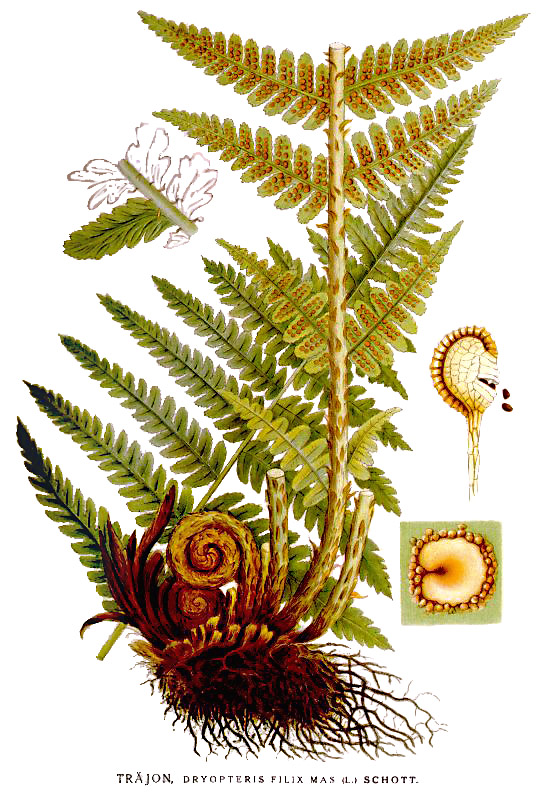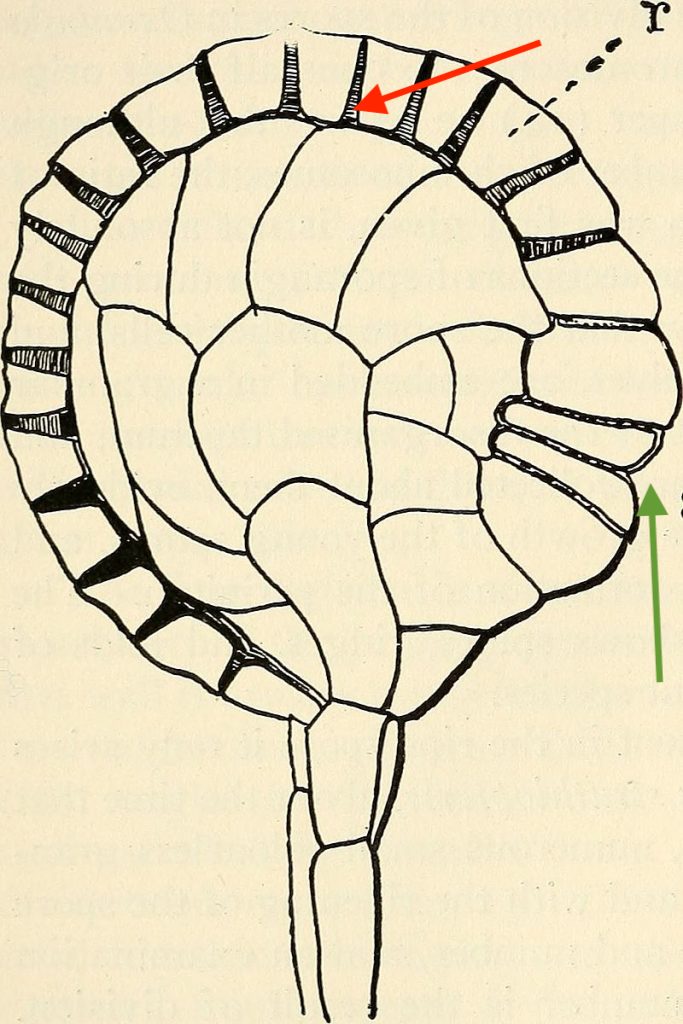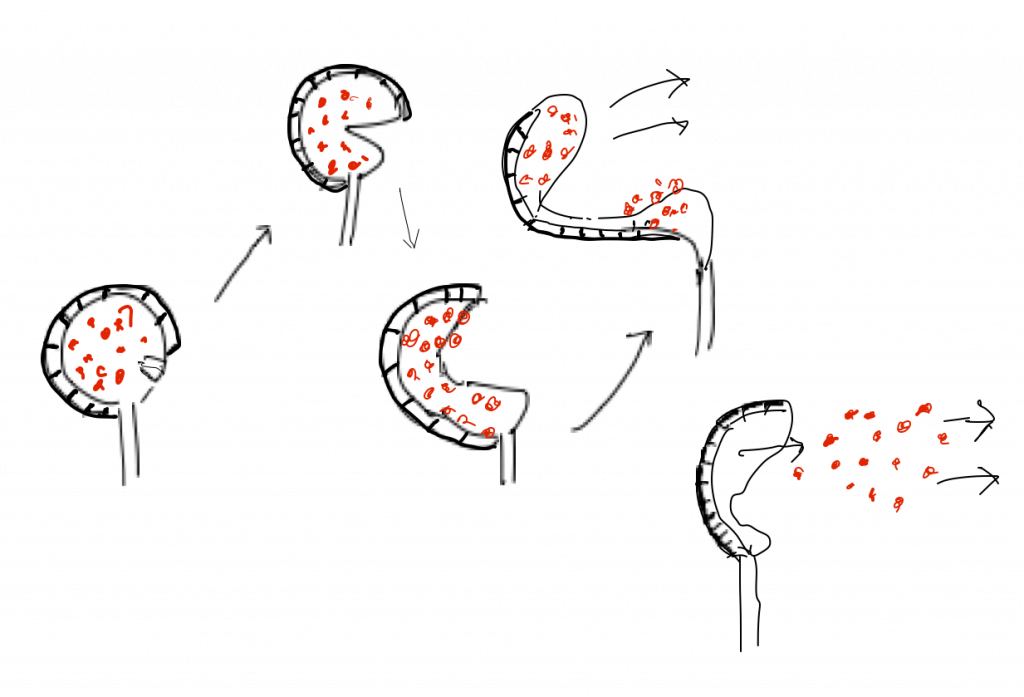Wood ferns
The wood ferns (genus Dryopteris) are a group of over 400 species and are commonly seen throughout temperate areas, especially in forests. Many are planted as ornamental plants and they are commonly used in landscaping and gardens. The group is known for hydridization, polyploidy and subsequent speciation which accounts for the large number of species (see discussion of speciation through polyploidy in Chapter 28).
Taxonomy and Phylogeny
Wood ferns are members of the Pterophyta, the fern group, which includes ferns, horsetails and wisk ferns. Most observers recognize ten orders within the group, the largest of these is the Polypodiales, which contains roughly 80% of the roughly 12,000 species put in the Pterophyta and is the order that contains the Dryopteridaceae, the family of roughly 1700 species that contains Dryopteris. Among other features that unite the Polypodiales is a sporangium with a band of cells, the annulus, that is interrupted by the stalk that attaches the sporangium to the fern leaf.

Structure
Wood ferns have an underground stem (rhizome) from which emerge the leaves. In most of the wood ferns the leaves are produced in clusters that produce an urn-like, circular groups of leaves. Leaves emerge in the spring as fiddleheads, exhibiting what is know as ‘circinate vernation’ i.e. they are coiled and unfurl from the base upwards. The leaves of most wood ferns are dissected 2-4 times. The petiole (stipe) of the leaf generally has large, scale-like outgrowths. Sporangia are produced on the underside of leaves in clusters called ‘fruit dots’. There is a flap of tissue called an indusium that covers the cluster of sporangia.

Reproduction
Like all plants, wood ferns exhibits alternation of generations with a visible sporophyte and hard-to-find bisexual gametophyte that is small, uncommonly seen, and quickly over grown by the sporophyte that grows out from the archegonia. Sperm are flagellated and swim to the egg.
The sporangia of all ferns in the Polypodiales are small stalked structures less than a millimeter tall.  They have a band of specialized cells, called an annulus (red arrow on the top), that run, starting at the stalk, around roughly 80% of the circumference of the sporangium. As the sporangium starts to dry the sporangium splits between two cells just below the annulus (green arrow, on the right). The cells of the annulus have specialized thickenings that can store energy as the sporangia dries and the annulus shortens to fully open the sporangium. The shrinkage generates a tension in the annulus that eventually overcomes the strength of water columns that are holding the annulus together. When the water columns break, the top of the sporangium rapidly snaps back, dispersing the spores into the air.
They have a band of specialized cells, called an annulus (red arrow on the top), that run, starting at the stalk, around roughly 80% of the circumference of the sporangium. As the sporangium starts to dry the sporangium splits between two cells just below the annulus (green arrow, on the right). The cells of the annulus have specialized thickenings that can store energy as the sporangia dries and the annulus shortens to fully open the sporangium. The shrinkage generates a tension in the annulus that eventually overcomes the strength of water columns that are holding the annulus together. When the water columns break, the top of the sporangium rapidly snaps back, dispersing the spores into the air.
 Matter and energy
Matter and energy
Wood ferns (both the sporophyte and gametophyte) are a typical photoautotroph s, using the energy of sunlight to synthesize carbohydrates from carbon dioxide and then using the carbohydrates as an energy source in cellular respiration and as building materials to synthesize a variety of biomolecules. In addition to the water and carbon dioxide needed to make carbohydrates, plants require an additional 14 elements, absorbed from the soil where they are present in dilute amounts, requiring the roots to ‘mine’ the soil.
Interactions
Wood ferns contains a number of toxins and are rarely grazed by mammals but are eaten by some caterpillars. Wood ferns are found throughout the eastern U.S., generally in forested situations.
Further Reading
- “The fern sporangium catapult” by xavier noblin. Explanation and video of spore discharge.
- A Natural History of Ferns by Robbin Moran, ISBN 1604690623. Great book on ferns.
Media Attributions
- Fiddlehead © Rorolinus is licensed under a CC BY-SA (Attribution ShareAlike) license
- Dryopteris filix-mas © Carl Axel Magnus Lindman is licensed under a Public Domain license
- Image from page 357 of “The structure and development of mosses and ferns (Archegoniatae)” (1918) with annotations © Douglas Houghton Campbell adapted by George Briggs is licensed under a Public Domain license
- Dryopteris Fern Spores © George Briggs is licensed under a CC BY-SA (Attribution ShareAlike) license

